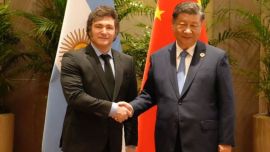The Javier Milei administration’s diplomatic shift towards Washington is an opportunity for US President Donald Trump to start reducing China’s influence in Latin America. Trump’s Treasury Secretary Scott Bessent expressed it as part of the context of activating financial assistance: “Milei is committed to getting China out of Argentina,” he said in an interview.
Data shows that the Asian superpower’s investment in this country is US$23.345 billion, with its strategic value outweighing its quantitative and distributed among sectors where the United States would like to be.
Beijing not only financed but constructed and purchased assets in the sectors which today are the motor of Argentina’s recovery, from the Vaca Muerta shale formation in Patagonia to lithium in the north of the country. Nobody believes that the Trump administration will request disinvestment, rather “avoiding China making new investments in areas which might be sensitive for US geopolitical interests,” commented international trade expert Marcelo Elizondo.
The main obstacle to "taking China out" of Argentina is that the Asian giant operates more as a banker of last instance than as a traditional investor. Of that US$23 billion, some US$10.6 billion correspond to financing critical infrastructure, like the rehabilitation of Belgrano Cargas freight line or crucial hydroelectric dams in the south, as can be gleaned from a document of the Sino-Chinese Chamber of Commerce, to which Perfil had access.
Since the start of the Milei administration – whether from the general cooling of relations with the presidential statements or the gaffes of officials like the former foreign minister Diana Mondino last year – many financed projects with China are suspended. But cutting the links outright would mean going out to look for a new creditor willing to sink billions of dollars into initiatives where the White House has historically shown scant interest in financing "bricks."
Where the equation becomes more complex is in the property of the strategic resources. China has destined over US$8.1 billion to the direct purchase of firms (mergers and acquisitions), ensuring key shareholdings in oil companies like Bridas (via CNOOC) or in gold and lithium deposits.
While the United States is arriving late in the race for critical minerals, companies like Ganfeng Lithium already have their plants up and exporting.
Yuans in the ground
Of the total US$23.345 billion, some US$4.6435 billion corresponds to genuine greenfield projects. Far from the myth of giving absolute importance to primary products, these new investments are headed by industrial plants (US$1.466 billion) and wind energy (US$942 million), relegating lithium to third place as to outlay on construction, although highly effective – the Ganfeng Lithium plant in Salta, an investment of US$600 million, is already an operational reality and exporting whereas the United States is still discussing how to enter the business.
Nevertheless, the X-ray of the state of these 21 projects reveals that while 10 of them are fully functional – including the US$500 million invested in Loma Blanca wind farms – the list also includes ‘white elephants.’ The megaproject of US$1.37 billion for an agrichemical plant and port remains in an administrative limbo, agreements over the Portezuelo del Viento dam (US$712 million) have not yet been signed and cases like Ambassador Fueguina SA ended up going broke.
Of the package of new projects, some US$2.73 billion (almost 60 percent) is genuine Foreign Direct Investment (FDI) where the Chinese capital assumes the commercial risk and property rights, as happens with lithium projects or the factory plants.
The rest, some US$1.914 billion, corresponds to turnkey contracts, a model where China places the technology, constructs the infrastructure (fundamentally wind farms and dams) and hands over the key, thus insuring the sale of their plant without necessarily tying themselves to the long-term operational Argentine risk.
Chinese financing
Another Excel column to which Perfil had access, financing, bespeaks a greater weight. Of the US$10.616 billion loaned by Chinese banks, almost 95 percent is concentrated in barely two items which define the national logistical and energy matrix: the hydroelectric dams in Santa Cruz and the revival of freight trains.
Some US$8 billion is assigned to the hydro dams Néstor Kirchner and Jorge Cepernic, works which today figure as “under construction” but in reality have been suspended since the start of the libertarian administration. Their cancellation would not only mean a technical default on the contracts but also leave two half-done concrete dikes in Patagonia without a purpose.
While minor projects like expansion of the Gran Rosario port (US$27 million) already figure as “completed,” the big projects remain open. The case of Belgrano Cargas freight, an injection of US$2.099 billion which today is fully operational (“functioning”), shows that Argentina’s northern railway system already runs on tracks financed by Beijing. Disactivating this scheme would be a challenge for financial engineering.
Purchase of assets
The direct purchase of assets in Argentina totals some US$8.117 billion, destined exclusively to acquiring shares in the control of companies operating in non-renewable resources.
The focus is clear: around 75 percent (some US$6.05 billion) went to the sector of fossil fuels while mining (gold and lithium) drew a further US$2 billion. Here neither the works are financed nor plants constructed from zero – the “key” to the resource is purchased, as CNOOC did when paying US$3.1 billion for half of Bridas Corp, or Shandong Gold when remitting US$1.105 billion to become a partner of Barrick in Veladero.
Nevertheless, some investments did not stay the distance. The classic example is SINOPEC, which – after injecting US$2.45 billion for shares of Occidental Petroleum – ended up selling their stocks off to the local CGC, making a heavy disinvestment. To that should be added the case of the Sierra Grande mine, a purchase of US$442.5 million which has remained paralysed since 2016.
The epicentre of the Chinese footprint is Patagonia, specifically the province of Santa Cruz, where the dams Néstor Kirchner and Jorge Cepernic are located, converting the district into the biggest recipient of Beijing funds.
The Northwest has consolidated itself as Argentina’s second strategic hub, thanks to lithium and solar energy. Between Salta and Jujuy, projects like the Ganfeng Lithium plants or the Caucharí solar park add investments of over US$1.2 billion, vital for provincial accounts.
Mendoza (with oil and mining ventures of over US$3.7 billion) and Tierra del Fuego (with its electronics hub and petchem projects worth US$1.5 billion) also depend, in the final analysis, on capital reporting to the country ruled by Xi Jinping.
"Taking out China" would indeed imply removing the financing of Patagonia’s biggest public works while bringing the export boom of the north to a halt.























Comments